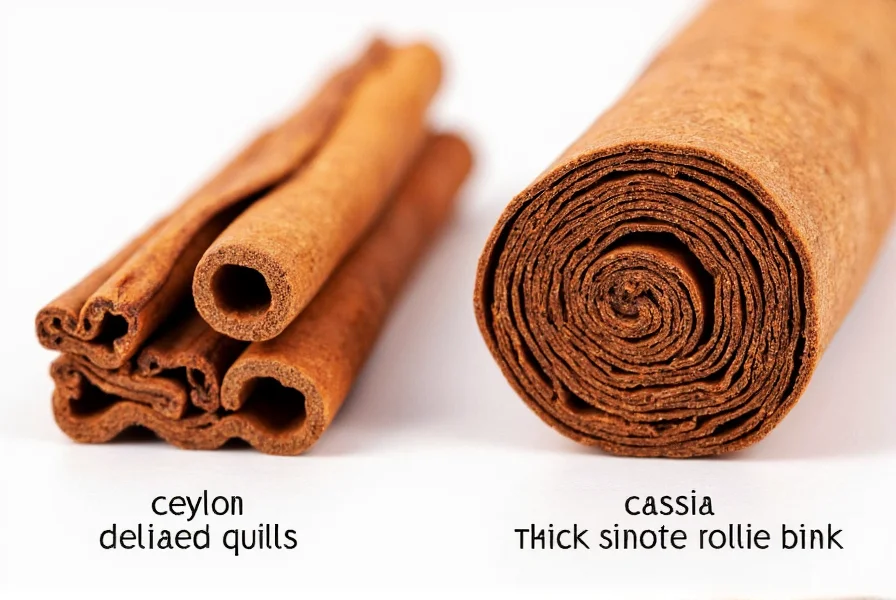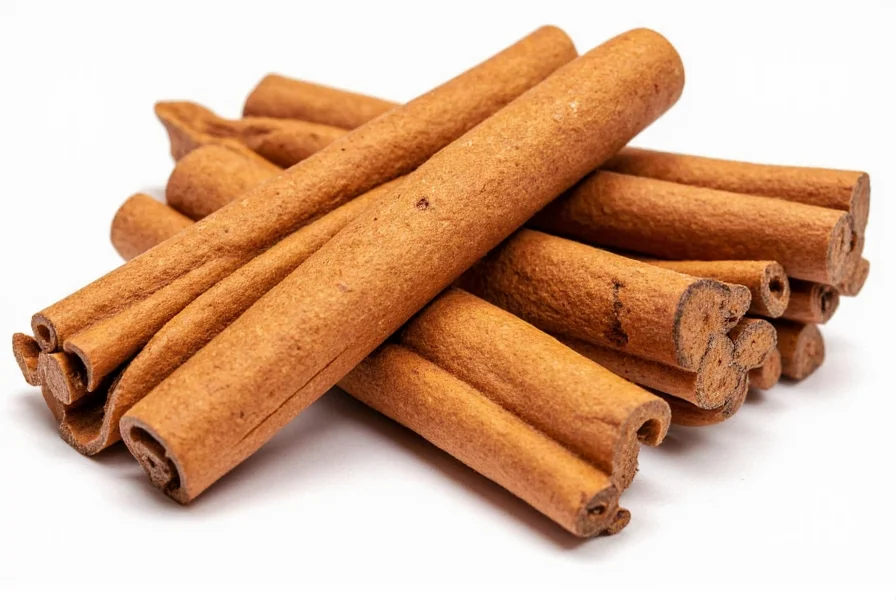When comparing ceylon cinnamon versus cassia cinnamon, understanding their fundamental differences is crucial for both culinary applications and health considerations. These two varieties dominate the global cinnamon market but possess distinct characteristics that affect flavor profiles, nutritional content, and safety for regular consumption.
What Exactly Is Ceylon Cinnamon?
Known as "true cinnamon," Ceylon cinnamon (Cinnamomum verum) originates from Sri Lanka and southern India. This delicate variety features multiple thin layers of bark that form a soft, hollow tube when dried. Its production process is more labor-intensive, contributing to its higher price point—typically 5-10 times more expensive than cassia.
Chefs and bakers favor ceylon cinnamon for its subtle, sweet flavor with citrusy notes that won't overpower delicate dishes. This makes it particularly valuable in dessert recipes, beverages, and applications where cinnamon should complement rather than dominate other flavors.

Understanding Cassia Cinnamon
Cassia cinnamon, primarily from China and Indonesia (Cinnamomum cassia), accounts for approximately 90% of cinnamon consumed in the United States. Its bark forms a single, thick, hard roll that's difficult to break. Cassia delivers a stronger, more pungent flavor with noticeable heat—ideal for robust recipes like chai tea, spice cakes, and savory dishes requiring bold seasoning.
The production process for cassia is less labor-intensive, making it significantly more affordable. This economic advantage explains its dominance in commercial food production and grocery store spice aisles. When examining difference between ceylon and cassia cinnamon, price remains one of the most immediately noticeable distinctions.
Key Differences Between Ceylon and Cassia Cinnamon
| Characteristic | Ceylon Cinnamon | Cassia Cinnamon |
|---|---|---|
| Bark Structure | Multiple thin layers, soft and brittle | Single thick layer, hard and dense |
| Color | Light tan to medium brown | Dark reddish-brown |
| Taste Profile | Mild, sweet, citrus notes | Strong, spicy, slightly bitter |
| Coumarin Content | 0.017-0.114 g/kg (very low) | 2.1-6.97 g/kg (very high) |
| Price | Higher (5-10x cassia) | Lower (more affordable) |
| Origin | Sri Lanka, India | China, Indonesia, Vietnam |
Health Implications: The Critical Coumarin Difference
The most significant difference between ceylon and cassia cinnamon lies in coumarin content. Coumarin, a naturally occurring compound, can cause liver toxicity when consumed in high amounts over time. European Food Safety Authority sets the tolerable daily intake at 0.1 mg per kilogram of body weight.
Consuming just one teaspoon (2.5g) of cassia cinnamon may exceed the safe coumarin limit for a 150-pound person. This makes cassia problematic for regular consumption, particularly for individuals using cinnamon supplements or adding multiple teaspoons daily to foods and beverages.
When evaluating ceylon cinnamon health benefits versus cassia, research shows both varieties contain similar levels of beneficial compounds like cinnamaldehyde and antioxidants. The primary health distinction relates to coumarin exposure rather than positive nutrient differences.
Nutritional Comparison
| Nutrient (per 1 tsp/2.6g) | Ceylon Cinnamon | Cassia Cinnamon |
|---|---|---|
| Calories | 6 | 6 |
| Carbohydrates | 2g | 2g |
| Fiber | 1g | 1g |
| Manganese | 26% DV | 26% DV |
| Calcium | 6% DV | 6% DV |
| Coumarin | Trace amounts | 5-12mg |
How to Identify Each Type
Telling the difference between ceylon and cassia cinnamon requires careful observation:
- Visual inspection: Ceylon forms thin, multi-layered quills resembling cigar tubes, while cassia creates thick, single-roll sticks
- Texture test: Ceylon crumbles easily between fingers; cassia remains hard and requires significant force to break
- Taste evaluation: Ceylon offers subtle sweetness; cassia delivers immediate heat and intensity
- Label reading: Check for "Cinnamomum verum" (ceylon) or "Cinnamomum cassia" (cassia) on packaging

When to Choose Ceylon Over Cassia (and Vice Versa)
Selecting between ceylon cinnamon versus cassia cinnamon depends on your specific needs:
Choose Ceylon when:
- You consume cinnamon regularly (daily)
- Preparing delicate desserts, custards, or beverages
- Creating recipes where cinnamon shouldn't dominate other flavors
- You have liver concerns or take medications metabolized by the liver
- Using cinnamon supplements or adding multiple teaspoons to foods
Choose Cassia when:
- Budget constraints exist
- Preparing robust dishes like curries, stews, or strong spice blends
- Using cinnamon occasionally rather than daily
- Creating traditional recipes specifically calling for cassia's stronger flavor
- Producing commercial food products where cost matters significantly
Practical Recommendations for Consumers
For most home cooks, maintaining both varieties serves different culinary purposes. Keep cassia for occasional use in bold recipes and ceylon for daily consumption and delicate dishes. If purchasing cinnamon supplements, verify they specify "ceylon" or "low coumarin" varieties.
When exploring is ceylon cinnamon better than cassia, the answer depends on context. For flavor intensity and cost, cassia wins. For safety in regular consumption and subtle flavor applications, ceylon is superior. Understanding these distinctions helps maximize both culinary enjoyment and health considerations when using this popular spice.
Frequently Asked Questions
Which cinnamon is better for managing blood sugar levels?
Both ceylon and cassia cinnamon show potential blood sugar benefits in research studies. The active compounds responsible for these effects exist in similar concentrations in both varieties. For regular consumption aimed at blood sugar management, ceylon is preferable due to its lower coumarin content, making it safer for daily use without liver concerns.
Can I substitute ceylon cinnamon for cassia in recipes?
Yes, but with adjustments. Ceylon's milder flavor means you may need 1.5-2 times the amount to achieve similar intensity. In delicate recipes like custards or light cakes, use equal amounts. For robust dishes like curries or spice cakes, increase ceylon by 50% to match cassia's impact. Always taste as you go when substituting between ceylon and cassia cinnamon.
How much cassia cinnamon is safe to consume daily?
Based on coumarin content, adults should limit cassia cinnamon to no more than 1 teaspoon (approximately 2.5g) daily. Those with liver conditions or taking medications should reduce this to ½ teaspoon or consider switching to ceylon. Regular consumption exceeding these amounts may increase liver damage risk over time, especially when combined with other coumarin sources.
Does ceylon cinnamon have the same health benefits as cassia?
Research indicates both varieties contain similar levels of beneficial compounds like cinnamaldehyde and polyphenols responsible for antioxidant and anti-inflammatory effects. The primary difference lies in coumarin content, not beneficial compounds. When evaluating ceylon cinnamon health benefits versus cassia, the safety profile for regular consumption makes ceylon preferable, while the positive health effects appear comparable between both types.
Why is most store-bought cinnamon cassia rather than ceylon?
Cassia dominates store shelves primarily due to lower production costs and stronger flavor that stands out in processed foods. Its thicker bark yields more product per tree, and the more intense flavor remains noticeable even in small amounts in commercial products. Most consumers cannot distinguish between ceylon and cassia cinnamon by taste alone in processed foods, making cassia the economical choice for manufacturers despite ceylon's safety advantages.











 浙公网安备
33010002000092号
浙公网安备
33010002000092号 浙B2-20120091-4
浙B2-20120091-4